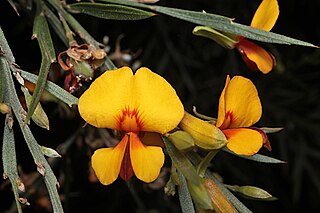
Jacksonia sericea, commonly known as waldjumi, is a species of flowering plant in the family Fabaceae and is endemic to the south-west of Western Australia. It is a spreading to prostrate shrub with greyish-green branches, straight, sharply-pointed side branches, leaves reduced to scales, orange flowers with red markings, and woody, densely hairy pods.

Jacksonia lehmannii is a is a species of flowering plant in the family Fabaceae and is endemic to the south-west of Western Australia. It is an erect to prostrate or spreading, spindly shrub with greyish-green branches, sharply-pointed side branches, its leaves reduced to scales leaves, yellowish-orange flowers with orange-red markings, and woody, hairy pods.

Jacksonia horrida is a species of flowering plant in the family Fabaceae and is endemic to the south-west of Western Australia. It is an erect or spreading to prostrate, bushy shrub with greyish-green branches ending in short, flattened, sharply-pointed side branches, the leaves reduced to scales and the flowers scattered and yellow-orange with red markings.

Jacksonia anthoclada is a species of flowering plant in the family Fabaceae and is endemic to the south-west of Western Australia. It is an erect, single-stemmed shrub with hairy, elliptic to egg-shaped phylloclades with sharply-pointed edges, yellow-orange flowers with red markings, and hairy, woody pods.

Jacksonia alata is a species of flowering plant in the family Fabaceae and is endemic to the south-west of Western Australia. It is a tufted, semi-prostrate to erect shrub with flattened branches, sharply-pointed side branches or phylloclades, leaves reduced to narrowly lance-shaped scales, yellow-orange flowers with a red "eye", and woody, densely hairy pods.

Jacksonia angulata is a species of flowering plant in the family Fabaceae and is endemic to the south-west of Western Australia. It is a tufted, spreading to prostrate shrub often with zig-zagged branches, sharply-pointed side branches or phylloclades, leaves reduced to broadly egg-shaped scales, yellow-orange to orange flowers with a red "eye", and woody, densely hairy pods.

Jacksonia arenicola is a species of flowering plant in the family Fabaceae and is endemic to the south-west of Western Australia. It is an erect, broom-like shrub with densely hairy, sharply-pointed phylloclades, yellow-orange flowers with red markings, and woody pods that are hairy at first, later glabrous.
Jacksonia arida is a species of flowering plant in the family Fabaceae and is endemic to Western Australia. It is an erect or prostrate shrub with tangled branches, sharply-pointed branchlets, yellow-orange to orange flowers, and woody pods.

Jacksonia calcicola is a species of flowering plant in the family Fabaceae and is endemic to the south west of Western Australia. It is a prostrate spreading or erect, prickly shrub with short, curved backwards and sharply pointed end branches, yellow-orange flowers with red markings, and woody, hairy pods.
Jacksonia carduacea is a species of flowering plant in the family Fabaceae and is endemic to the south-west of Western Australia. It is a bushy shrub with its end-branches elliptic to egg-shaped phylloclades, and yellow-orange flowers in clusters in the axils of phylloclades.
Jacksonia chappilliae is a species of flowering plant in the family Fabaceae and is endemic to a restricted area of northern New South Wales. It is an erect shrub with its end-branches sharply-pointed phylloclades, and yellow-orange flowers with red markings scattered along the branches.

Jacksonia compressa is a species of flowering plant in the family Fabaceae and is endemic to the south west of Western Australia. It is an erect, bushy shrub with sharply pointed end branches, yellow-orange flowers with red markings, and woody, hairy pods.

Jacksonia debilis is a species of flowering plant in the family Fabaceae and is endemic to the south west of Western Australia. It is a spreading to prostrate shrub with curved phylloclades, yellow-orange flowers with red markings, and woody, hairy pods.
Jacksonia dendrospinosa is a species of flowering plant in the family Fabaceae and is endemic to the far west of Western Australia. It is a dense, erect shrub or tree with straight, sharply-pointed branches, leaves reduced to scales, scattered yellow-orange flowers with red markings, and membranous, hairy pods.

Jacksonia elongata is a species of flowering plant in the family Fabaceae and is endemic to the south of Western Australia. It is an erect or spreading, spindly shrub with yellowish-green branches, yellow-orange flowers with red markings, and woody, densely-hairy pods.
Jacksonia epiphyllum is a species of flowering plant in the family Fabaceae and is endemic to the south of Western Australia. It is an erect or straggling shrub, the end branches egg-shaped or elliptic phylloclades, the leaves reduced to scale leaves, the flowers yellow-orange with red markings, and woody, densely-hairy pods.
Jacksonia eremodendron is a species of flowering plant in the family Fabaceae and is endemic to the south-west of Western Australia. It is a straggling shrub to small tree, the end branches egg-shaped, elliptic or oblong phylloclades with sharply-pointed teeth on the edges, the flowers yellow-orange with red markings and attached to teeth on phylloclades, and woody, densely-hairy pods.

Jacksonia forrestii, commonly known as broom bush, is a species of flowering plant in the family Fabaceae and is endemic to the north-west of Australia. It is an erect, slender, weeping shrub or tree with sharply pointed phylloclades, yellow to yellow-orange flowers without markings, and woody, hairy pods.

Jacksonia grevilleoides is a species of flowering plant in the family Fabaceae and is endemic to the south west of Western Australia. It is a prostrate or erect shrub with variably-shaped phylloclades, yellow-orange flowers and woody, densely hairy pods.

Jacksonia hakeoides is a species of flowering plant in the family Fabaceae and is endemic to the south west of Western Australia. It is a low, densely-branched shrub with sharply-pointed end branches, the leaves reduced to scales, yellow-orange to orange flowers with red markings, and woody, densely hairy pods.














